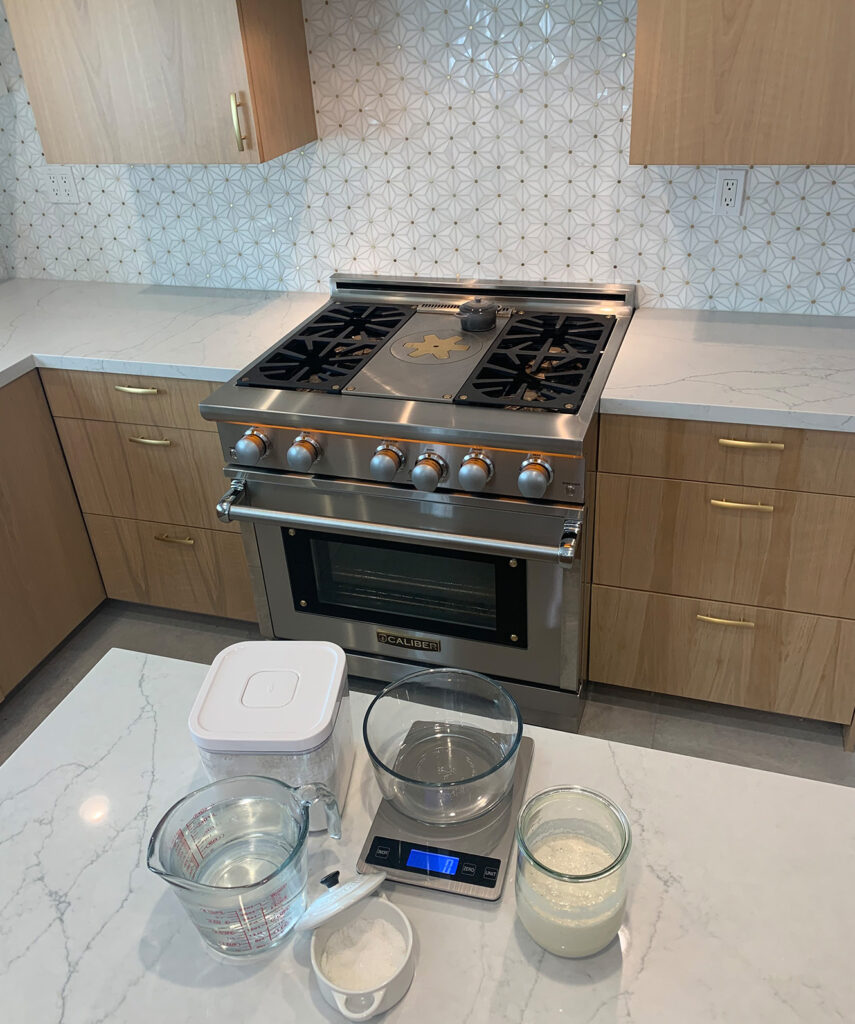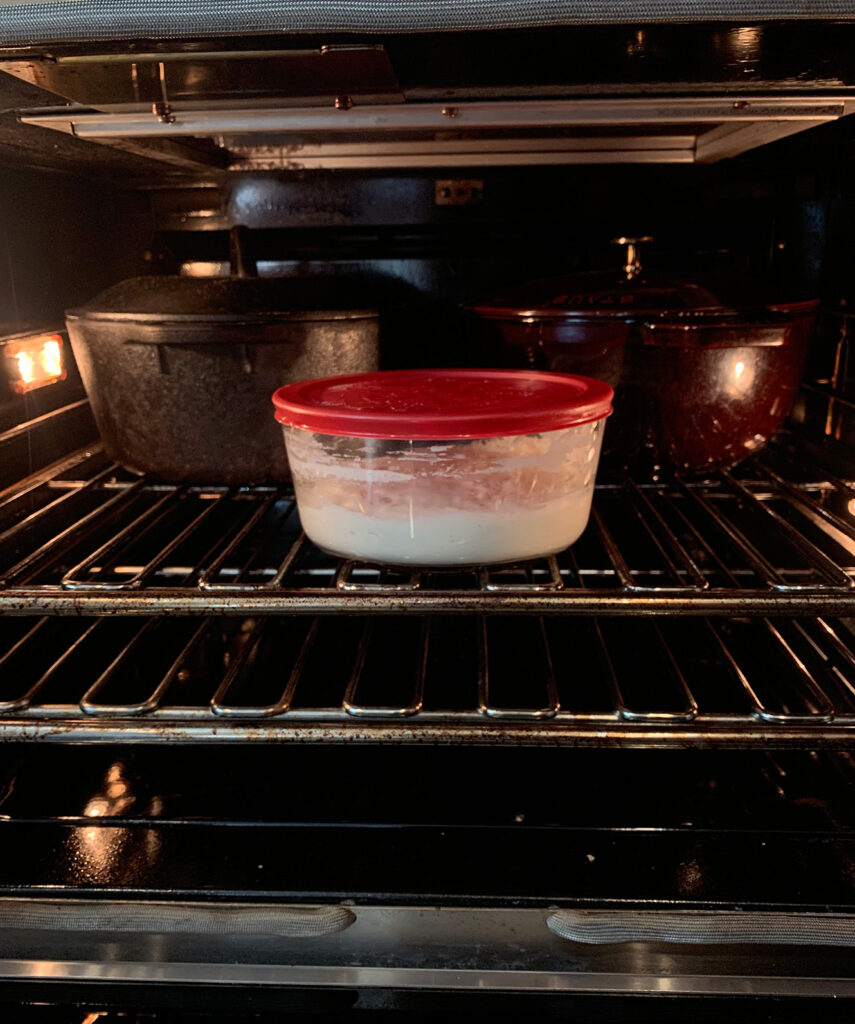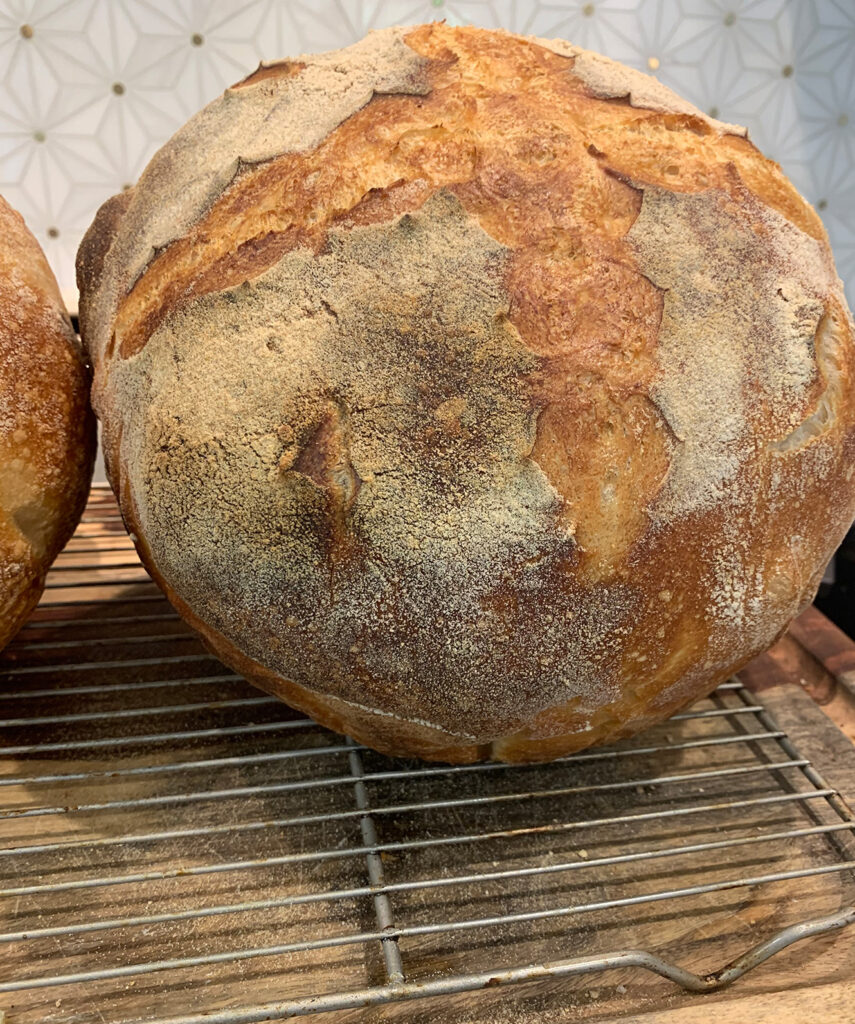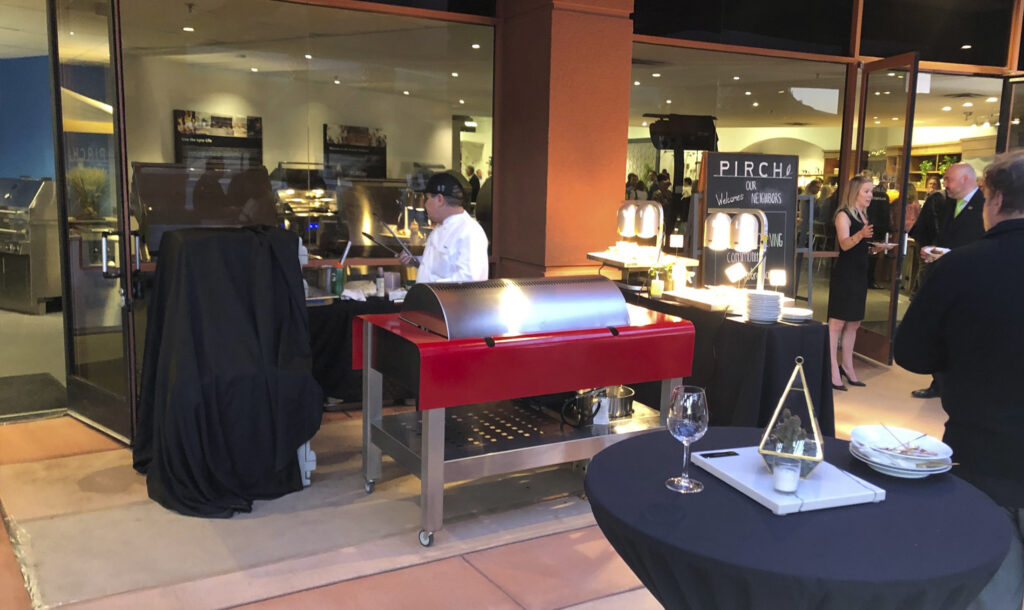
Thank you Home Chef Christina for this wonderful “Bread Creation” tutorial and recipe on your Caliber Indoor Professional Range! Now take it away Christina with your tutorial:
This is more of a creation than a recipe. I have been keeping a bread journal . . . . Yes, a bread journal. I have been trying different techniques and also asking friends who bake bread. So this is a combo of CREATING BREAD from online tutorials, my brother-in-law’s kitchen, and a book I’m obsessed with called Flour Water Salt Yeast.
This creation uses a sour dough starter instead of yeast to rise. It takes 7-10 days to create a sour dough starter. I created mine using a few different methods and – changed things up along the way – couldn’t tell you how to get my exact method, if I tried, (thus the reason I started the bread journal). I suggest you look up recipes online or better yet, if you have a friend who has a starter – beg, borrow or steal it from them.

TOOLS:
- Food Scale (non-negotiable)
- Container for your starter (I use a Weck Tulip Jar – size large)
- Container with Lid – for primer
- Bowl
- Spatula or spoon
- Kitchen Towel
- Pastry Scraper
- Parchment paper
- Dutch OVEN (I use LODGE cast iron and STAUB)
- Proofing basket (or parchment lined bowl)
- CALIBER RANGE
INGREDIENT LIST:
- Sourdough Starter
- Bread Flour
- Water (lukewarm)
- Salt
- Rice Flour for dusting – only necessary if using a proofing basket

STEP 1: THE STARTER! A healthy starter is the key to this. I feed mine the day before I’m going to bake with 3 TBS bread flour and 2 TBS lukewarm water. Stir it up and make sure it’s been allowed to rest for 8-16 hours from feeding.
STEP 2: Make the PRIMER
- 100 grams of lukewarm water
- 75 grams of sourdough starter
- 100 grams of bread flour
Start with water and then add in your starter. Stir to combine then add the flour and stir to combine: done in this order, it mixes up better. In the end, your scale should read 275 grams of primer. Put the cover on and place in your oven with the oven light on. This is called proofing. The Caliber oven light is strong enough that even in the cold winter months, my primer was able to activate within 2-4 hours.
STEP 3: Make the DOUGH
- 400 grams of lukewarm water
- 200 grams of primer
- 600 grams of bread flour
- 16 grams of salt
Measure out the water and add 200 grams of primer into the water. The primer should float slightly on top of the water. This is an indicator of a good primer and will ensure you get a BEAUTIFUL looking loaf. Stir to combine. Add bread flour and salt. Stir to combine.
Cover with a wet dish towel or a lid and let it rest for 1 hour. This allows the flour to fully incorporate.
STEP 4: PULL and PUSH
This is the first step to incorporate air and get that dough moving. With your hand grab a portion of the dough from the outside and gently lift it into the air (PULL) but don’t let it separate from the rest of the dough and then put (PUSH) it back into the dough, placing it into the center. Turn the bowl a quarter turn and grab the next section. You will do this 4-5 times depending upon how much you turn your bowl. Don’t worry, if you do this 3 times or 8 times, it ends up the same (bread journal notes talking here) cover and allow it to rest for 3-6 hours. There are great tutorials online to show you this technique
STEP 5: KNEADING
One you have seen the bread rise and poof up a bit – you know that it’s ready to knead. I don’t use flour for this part. The bread will be slightly sticky – but if you keep things moving – you won’t have too much waste. I can describe my kneading technique as a SLAP, PULL, ROLL, TURN process. Take all of the dough out of the bowl and SLAP it down onto a clean hard surface (I use my quartz countertop). PULL or lift the dough off the surface and ROLL as you’re doing this to and then TURN it and SLAP it down, PULL up and ROLL the dough over and TURN to continue. I do this 20-40 times. It really depends upon how the dough FEELS at this point. The dough should become less sticky and roll easy and start to feel fuller of air. COVER and let rest for 2-4 hours. Cleaning out your bowl in between may help it stick less.
STEP 6: SHAPING before the final rest
Flour your working surface and pastry scraper. Turn your dough out onto the surface. Your goal here is to add a little more air and shape the dough before its final rise. First, fold the dough over itself to make a half circle. Second, fold again to make a quarter circle. Now grab your scraper and use your other hand to turn the quarter circle while scraping and lifting with your other hand. You should be turning and scraping and lifting the dough off of the surface and forming it into a rounded mound.
STEP 7: FINAL RISE
Your bread will rest while you rest – it needs at least 6 hours for this step, but I have left it for 14 hours (because life happens) and it turned out great. The final rise happens in your FRIDGE.
Option 1: Use a proofing basket. Ensure there is enough rice flour in the proofing basket to keep the dough from sticking. Place your dough rounded side DOWN into the basket. So starring up at you is the bottom of the mound. Cover with a DAMP dish towel and put in the fridge.
Option 2: Use a parchment lined bowl. No need to add any flour or anything. Just make sure the parchment is large enough to overhang off the bowl once the dough is placed in. This will make the transfer to your Dutch oven easier. Use your scraping tool to put the dough rounded side UP into the bowl. So starring up at you is the smooth side of the dough. Cover with a DAMP dish towel and put in the fridge.

STEP 8: PRE-HEAT the oven and the Dutch oven
This is where the Caliber SHINES – this is your most important tool on the list. By just turning the lights on in the Caliber Indoor Pro Range it creates enough heat for the perfect environment for proofing bread. I bake 2 loafs at a time and use a STAUB and a LODGE Dutch oven and both come out fantastic.
Place your Dutch oven inside for the pre-heat process. Set your oven to 475 and pre-heat for 30 minutes.
STEP 9: BAKING (finally)
Pull your dough from the fridge
CAREFULLY remove your Dutch oven out of the oven and put your dough directly into the Dutch oven.
Option 1: Proofing basket. Place a piece of parchment paper over the top of the basket and turn it out so that the rounded dough is looking up at you. Lift the dough and parchment paper into the Dutch oven.
Option 2: Parchment lined bowl. Lift the parchment out of the bowl and place directly into the Dutch oven.
Trim off any parchment that sticks above the Dutch oven. Score the dough to allow air to properly escape. You can get lost in technique and design here – I have attempted a few, bought some fancy scoring tools, and I use kitchen scissors now. I create a simple X pattern on the top of the dough using my kitchen scissors to cut through the dough.
Put the lid on and place in the oven. CONVECTION BAKE at 475 for 28 minutes or 30 minutes if you want a CRUNCHIER crust. The bread will rise and be a LIGHT blonde color
Take the lid off and CONVECTION BAKE at 475 for 20 minutes. This is where the brown color and crunchy exterior comes in.
Remove from the oven and immediately put bread on a rack to cool. You don’t want to leave the bread in the Dutch oven – as it will continue to cook. I put my Dutch oven back into the oven and find that it cools down while the oven cools down.
STEP 10: WAIT . . . the hardest part.
If you want to have this bread for the week – it’s best to wait 4 hours before you slice into it. This keeps the bread from getting gummy and it makes it easier to slice.
But if you’re having company over – or plan to eat it all – go for it – who doesn’t love HOT bread.
Store on bread board covered with a dry kitchen towel or in a bread bag.

TIMELINE: It works best for me to bake in the am, so that’s how I came up with this schedule. If you keep your starter on the counter and have it ready – it only takes 18-24 hours to make bread. . . . You can start at “DAY TWO” portion of the timeline.
DAY ONE
- 8pm – Feed starter
DAY TWO
- 9am – make primer
- 1pm – make bread dough
- 2pm – first pull and push on dough
- 6pm – first round of kneading
- 8pm – last kneed and put in the fridge
DAY THREE
- 6am – heat up oven
- 7am – remove bread from fridge and prepare to bake
- 8am – bread is cooling
- 12pm – earliest I will cut the bread




